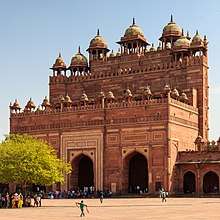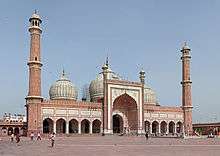Jama Mosque, Fatehpur Sikri
The Jama Masjid (Friday Mosque) is a 17th-century mosque in the World Heritage Site of Fatehpur Sikri in India. The Mughal emperor Akbar personally directed the building of the Jāmiʿ Masjid (Great Mosque; 1571), which stretches some 540 feet (165 metres) in length.[1] The mosque also known as the "Friday Mosque" is one of the largest mosques in India and is a most sought after pilgrimage site by the devotees. It is also one of the most visited tourist destinations in Agra district. Some of the designs of the mosque reflect beautiful Iranian architecture.

Architecture

The rectangular mosque comprises a central nave with a single dome, two colonnaded halls on either side, with two square chambers crowned with domes. Carved mihrabs adorn the main chamber and the two smaller rooms.
The mosque marks the phase of transition in Islamic art, as indigenous architectural elements were blended with Persian elements. The pillared dalan of the facade, the liwan with three arched openings framed by panels and crowned by five chhatris and the central mihrab adorned with an inlaid mosaic of stones that are bordered by glazed tiles, and golden inscriptions on a royal blue background is a tribute to this fusion. The interiors of the liwan are adorned with watercolour paintings depicting stylized floral designs. The dado panels, spandrels of arch and soffits are painted profusely. Unlike other monuments, where domes are supported on squinches, here corbelled pendentives support the dome.
The Buland Darwaza and the Tomb of Salim Chishti are also a part of the mosque complex.
See also
References
- The Editors of Encyclopædia Britannica. "Fatehpur Sikri". Encyclopædia Britannica. Retrieved 17 December 2017.
External links
| Wikimedia Commons has media related to Jama Masjid (Fatehpur Sikri). |

